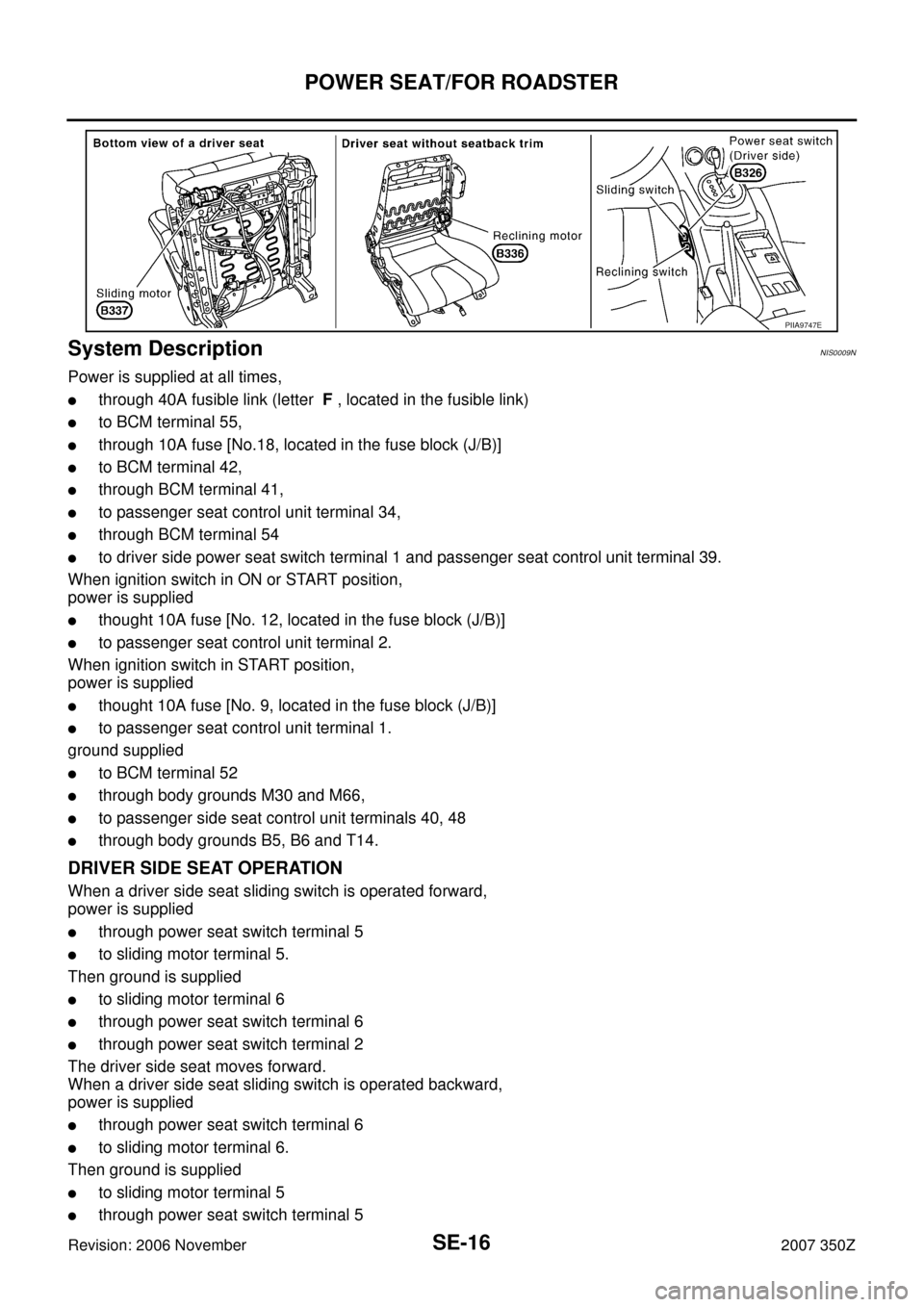Page 9 of 80

SQUEAK AND RATTLE TROUBLE DIAGNOSES
SE-9
C
D
E
F
G
H
J
K
L
MA
B
SE
Revision: 2006 November2007 350Z
TRUNK
Trunk noises are often caused by a loose jack or loose items put into the trunk by the owner.
In addition look for:
1. Trunk lid dumpers out of adjustment
2. Trunk lid striker out of adjustment
3. The trunk lid torsion bars knocking together
4. A loose license plate or bracket
Most of these incidents can be repaired by adjusting, securing or insulating the item(s) or component(s) caus-
ing the noise.
SUNROOF/HEADLINING
Noises in the sunroof/headlining area can often be traced to one of the following:
1. Sunroof lid, rail, linkage or seals making a rattle or light knocking noise
2. Sunvisor shaft shaking in the holder
3. Front or rear windshield touching headlining and squeaking
Again, pressing on the components to stop the noise while duplicating the conditions can isolate most of these
incidents. Repairs usually consist of insulating with felt cloth tape.
SEATS
When isolating seat noise it's important to note the position the seat is in and the load placed on the seat when
the noise is present. These conditions should be duplicated when verifying and isolating the cause of the
noise.
Cause of seat noise include:
1. Headrest rods and holder
2. A squeak between the seat pad cushion and frame
3. The rear seatback lock and bracket
These noises can be isolated by moving or pressing on the suspected components while duplicating the con-
ditions under which the noise occurs. Most of these incidents can be repaired by repositioning the component
or applying urethane tape to the contact area.
UNDERHOOD
Some interior noise may be caused by components under the hood or on the engine wall. The noise is then
transmitted into the passenger compartment.
Causes of transmitted underhood noise include:
1. Any component mounted to the engine wall
2. Components that pass through the engine wall
3. Engine wall mounts and connectors
4. Loose radiator mounting pins
5. Hood bumpers out of adjustment
6. Hood striker out of adjustment
These noises can be difficult to isolate since they cannot be reached from the interior of the vehicle. The best
method is to secure, move or insulate one component at a time and test drive the vehicle. Also, engine RPM
or load can be changed to isolate the noise. Repairs can usually be made by moving, adjusting, securing, or
insulating the component causing the noise.
Page 10 of 80
SE-10
SQUEAK AND RATTLE TROUBLE DIAGNOSES
Revision: 2006 November2007 350Z
Diagnostic WorksheetNIS0029D
PIIB8740E
Page 11 of 80
SQUEAK AND RATTLE TROUBLE DIAGNOSES
SE-11
C
D
E
F
G
H
J
K
L
MA
B
SE
Revision: 2006 November2007 350Z
PIIB8742E
Page 12 of 80
SE-12
POWER SEAT/FOR COUPE
Revision: 2006 November2007 350Z
POWER SEAT/FOR COUPEPFP:87016
Wiring Diagram–SEAT– /For Driver SeatNIS0009K
TIWT1611E
Page 13 of 80
POWER SEAT/FOR COUPE
SE-13
C
D
E
F
G
H
J
K
L
MA
B
SE
Revision: 2006 November2007 350Z
TIWT0723E
Page 14 of 80
SE-14
POWER SEAT/FOR COUPE
Revision: 2006 November2007 350Z
Wiring Diagram–SEAT– /For Passenger SeatNIS0009L
TIWT1612E
Page 15 of 80
POWER SEAT/FOR ROADSTER
SE-15
C
D
E
F
G
H
J
K
L
MA
B
SE
Revision: 2006 November2007 350Z
POWER SEAT/FOR ROADSTERPFP:25565
Component Parts and Harness Connector LocationNIS0009M
PIIB7413E
Page 16 of 80

SE-16
POWER SEAT/FOR ROADSTER
Revision: 2006 November2007 350Z
System DescriptionNIS0009N
Power is supplied at all times,
�through 40A fusible link (letter F , located in the fusible link)
�to BCM terminal 55,
�through 10A fuse [No.18, located in the fuse block (J/B)]
�to BCM terminal 42,
�through BCM terminal 41,
�to passenger seat control unit terminal 34,
�through BCM terminal 54
�to driver side power seat switch terminal 1 and passenger seat control unit terminal 39.
When ignition switch in ON or START position,
power is supplied
�thought 10A fuse [No. 12, located in the fuse block (J/B)]
�to passenger seat control unit terminal 2.
When ignition switch in START position,
power is supplied
�thought 10A fuse [No. 9, located in the fuse block (J/B)]
�to passenger seat control unit terminal 1.
ground supplied
�to BCM terminal 52
�through body grounds M30 and M66,
�to passenger side seat control unit terminals 40, 48
�through body grounds B5, B6 and T14.
DRIVER SIDE SEAT OPERATION
When a driver side seat sliding switch is operated forward,
power is supplied
�through power seat switch terminal 5
�to sliding motor terminal 5.
Then ground is supplied
�to sliding motor terminal 6
�through power seat switch terminal 6
�through power seat switch terminal 2
The driver side seat moves forward.
When a driver side seat sliding switch is operated backward,
power is supplied
�through power seat switch terminal 6
�to sliding motor terminal 6.
Then ground is supplied
�to sliding motor terminal 5
�through power seat switch terminal 5
PIIA9747E